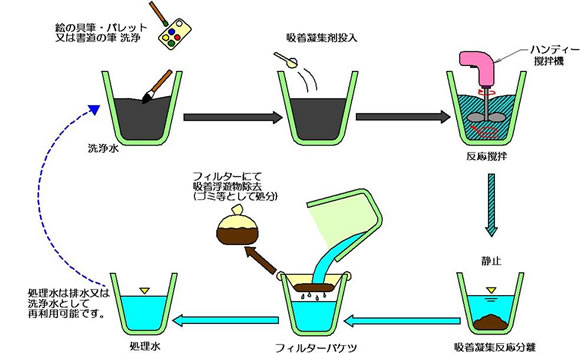Coagulation of inorganic materials
Inorganic adsorption of cohesive soils
Organic polymer used in most of the flocculation separation of processing and polluted water. Because polymer chemicals, environmental impact aquatic ecosystems and food chains, etc. by began is pointed out recently.
Also starting was pointed out and overflowed water flocculation separation high molecular polymers cause the clouded phenomenon over time, because it is waters, rivers etc water quality deterioration caused one of.
For viscous is a hydrophilic strong polymer, makes friendly water and dissolved substances are difficult to get rid of things, dangers and potential residual on water trace while it accumulates in the body, that negatively affect health.
To solve these issues specific nonprofit activity Corporation playing Hall could things to develop inorganic adsorption of cohesive soils under the guidance of the Tokyo Industrial University aritomi.
Inorganic adsorption of cohesive soils are absorbent chemicals and toxic substances in the water pollution pulverized ash and pulverized coal plants and animals the /-of viscous developed the combination of inorganic.
Combination of inorganic things changed behavior of polluted water by and enhance the effect of separation. Inorganic combination combining between 5 and 10 types, are made.
Aggregation adsorbent
This time, cohesive material developed is based on the mentoring aritomi Tokyo Industrial University and NPO Corporation regeneration Hall, developed a special supporting Member NPO Corporation regeneration Hall.
Adsorption of coagulant development purposes to purify the polluted water is used as the living water in the development of the developing country, was developed for safe living water utilization.
To develop the material can get cheap, in the development of the developing country by the noted that guidance from Professor Tetsuo in the development, use things of the natural world has been destroyed and absolute criteria, has been developing.
Is the main raw material of adsorbent cohesion of this were carbonized residue of the flora and fauna of pulverized charcoal and ash hydride, -developed, utilizing inorganic clay powder in.
By pulverized charcoal is the main purpose of adsorbed on absorbent toxic heavy metals and chemicals, inorganic powders intended clump together by nucleus made of and get water and water separation and safety.
Is kind of cohesive material developed crossed the 40 currently effectively shows the reaction against various polluted water now is also under study.
In effect of precipitation and prevent carbonation and cohesive substance to dissolve again thing is you thing to use aggregation adsorbent for the hydrogen ion concentration and suspended matter in the polluted water etc. by are main features of cohesive material developed.
Also not seen apparently turned Chengguan water isolated aggregation adsorbent Chengguan water flocculation separation such polymer that is typically done there thing c.i.e. over time is, was developed in largely clouded behavior over time is experimental results.
※ Unless there is cohesion since the separation of the turbid water joined water molecule concentration of turbidity and turbidity in extremely fine and more cohesive material content may be unable reaction. Also, go for cause coagulating separation efficiency is relatively strong turbulent agitation.
Agglutination tests and results
2009June 17th
Various muddying the cohesive material for and tailored to each use and filtered the reaction mixture.
1.River
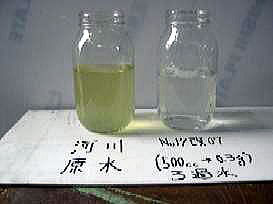 Raw water: S-River, Saitama
Raw water: S-River, Saitama
Cohesive material :No.12 break 07
After the 500 ml water to put cohesion 0.3 g materials, thoroughly stirred with pore diameter of 10 µm m damned fabrics were spent.
2. Muddy water
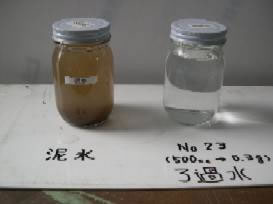 Raw water: muddy water
Raw water: muddy water
Cohesive material :No.23
After the 500 ml water to put cohesion 0.3 g materials, thoroughly stirred with pore diameter of 10 µm m damned fabrics were spent.
3. Asphalt turbid water
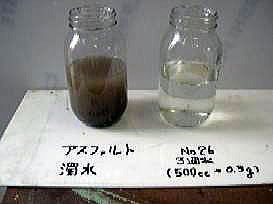 Raw water: asphalt cutting turbidity
Raw water: asphalt cutting turbidity
Cohesive material :No.26
After the 500 ml water to put cohesion 0.3 g materials, thoroughly stirred with pore diameter of 10 µm m damned fabrics were spent.
4. Turbid water concrete
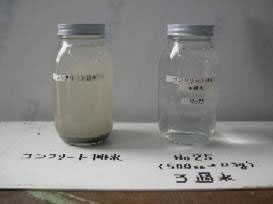 Water: concrete cutting turbidity
Water: concrete cutting turbidity
Cohesive material :No.25
After the 500 ml water to put cohesion 0.3 g materials, thoroughly stirred with pore diameter of 10 µm m damned fabrics were spent.
5. Indian ink
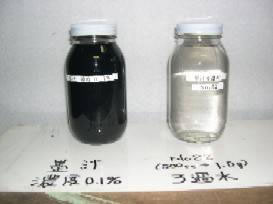 Raw water: ink ( concentration 0.1 span )
Raw water: ink ( concentration 0.1 span )
Cohesive material :No.22
After the 500 ml water to put cohesion 1.0 g materials, thoroughly stirred with pore diameter of 10 µm m damned fabrics were spent. Filtration water became clean in multiple installments, to introduce a cohesive material
6. Water-based paint, and water-based paints
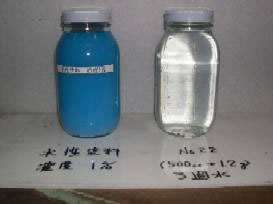 Raw water: water-based paint ( 1 span concentration>)
Raw water: water-based paint ( 1 span concentration>)
Cohesive material :No.22
After the 500 ml water to put cohesion 1.2 g materials, thoroughly stirred with pore diameter of 10 µm m damned fabrics were spent. Filtration water became clean in multiple installments, to introduce a cohesive material
Proposal of the drainage of the elementary and secondary schools
Includes guidance that prohibits calligraphy tools and painting tools (mainly water-based paint brush and palette) in primary and secondary school students number of wash in schools, each family to take home, wash.
This is considered the sewerage Act, etc. from the washing water exceeds, amount of effluent standards, for wash in schools prohibited. In this situation, no remains the burden to the environment.
Then, we develop a cohesive adsorbent using inorganic materials generated from the natural world, invites to purify these sewage drain or reused.
